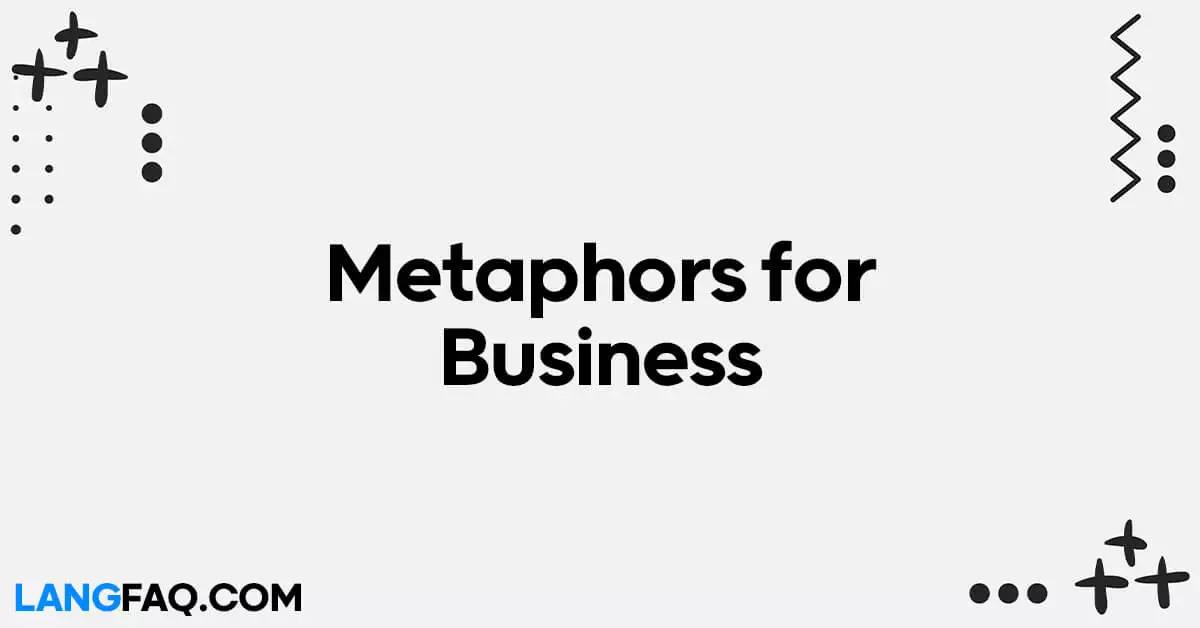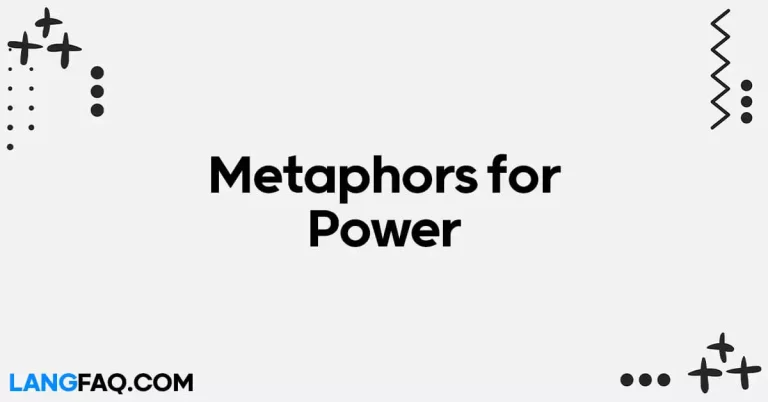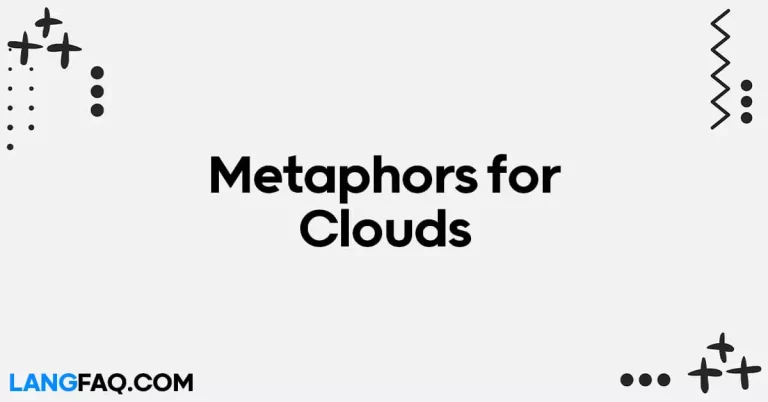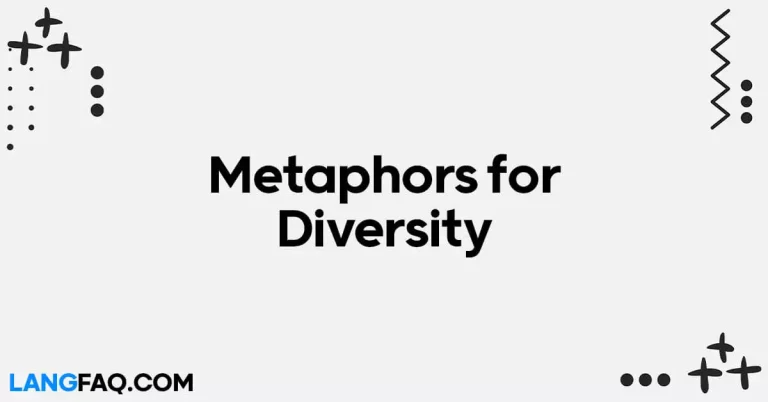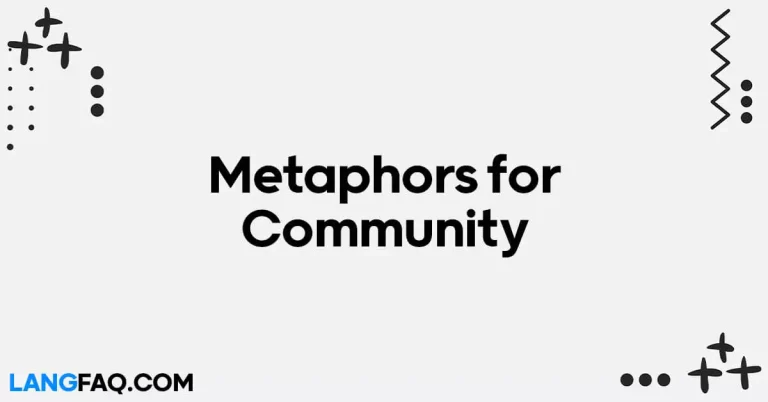Welcome to the poetic realm of business, where every deal, challenge, and success is a stanza in the ballad of entrepreneurship. In this article, we will unravel the intricate tapestry of 26 metaphors for business, shedding light on the profound connections between the literary and corporate worlds.
26 Metaphors for Business
- Business as a Chess Game: Strategizing and making calculated moves are crucial for success in both business and chess.
- Entrepreneurship is a Marathon: Long-term endurance and persistence are key traits in both running a business and running a marathon.
- The Butterfly Effect: Small decisions can have significant impacts on the overall success or failure of a business, much like the butterfly effect.
- Business is a Garden: Nurturing and cultivating relationships, ideas, and strategies are essential for growth, just like tending to a garden.
- The Symphony of Teamwork: Just as in a symphony, each member of a team plays a unique role to create a harmonious and successful outcome.
- Market Trends as a Maze: Navigating through market trends requires strategy, adaptability, and a keen sense of direction, much like finding your way through a maze.
- Decision-Making as a Crossroads: Decisions in business are akin to reaching a crossroads, where choosing the right path determines the direction of the journey.
- Business as a Tapestry: Woven together with diverse threads of creativity and innovation, a business creates a unique and intricate tapestry.
- The Phoenix Rising from Setbacks: Like a phoenix, businesses can rise from setbacks, emerging stronger and more resilient than before.
- Networking as a Fertile Garden: Building and nurturing professional relationships is like cultivating a fertile garden that yields opportunities and growth.
- Corporate Strategy as a Puzzle: Crafting a successful corporate strategy involves piecing together various elements to form a complete and effective picture.
- The Dance of Risk and Reward: Business is a dance where taking calculated risks can lead to rewarding outcomes, much like a well-choreographed performance.
- Cash Flow as a River: The continuous flow of cash is the lifeblood of a business, ensuring its vitality and sustainability.
- Leadership as a Sculpture: Effective leadership involves sculpting and shaping the organization, molding it into a strong and impactful entity.
- Global Expansion as a Symphony: Expanding globally requires harmonizing efforts across diverse markets, creating a symphony of success.
- Corporate Responsibility as an Ecosystem: Embracing corporate responsibility contributes to the overall health and well-being of the business environment, much like an ecosystem.
- Customer Relations as a Canvas: Interactions with customers paint a vivid canvas of trust, loyalty, and satisfaction.
- Innovation as a Firework Display: Sparking creativity and innovation in business is like a dazzling firework display, capturing attention and standing out in the market.
- Vision as a Lighthouse: A clear and compelling vision acts as a guiding lighthouse, directing the business through the vast sea of possibilities.
- Customer Feedback as a Beacon: Feedback from customers serves as a guiding beacon, leading the business towards improvement and excellence.
- Corporate Culture as an Orchestra: Each employee contributes to the harmonious culture of the organization, creating a successful and positive workplace.
- Market Competition as a Battlefield: Competing in the market requires strategic maneuvers and a well-thought-out battle plan.
- Business Meetings as a Theater: Meetings and presentations in business are like performances on a theater stage, requiring preparation and effective communication.
- Business Ethics as a Compass: Upholding ethical standards in business is akin to using a compass, guiding decisions in the right direction.
- Networking as a Spider Web: Building professional networks involves weaving connections, creating a strong and interconnected web of opportunities.
- The Corporate Journey as a Book: The story of a business unfolds like a book, with each chapter representing different stages, challenges, and achievements.
| Metaphor | Meaning | Example |
|---|---|---|
| Chess Game | Business requires strategic thinking and calculated moves, similar to playing chess. | Making a strategic business move is like planning your next move on a chessboard. |
| Marathon | Running a business is a long-term endeavor that requires endurance and persistence, much like running a marathon. | Entrepreneurship is a marathon, not a sprint; you need stamina for the long journey. |
| Butterfly Effect | Small decisions in business can have significant consequences, echoing the butterfly effect. | The decision to rebrand our product had a butterfly effect, positively impacting our market presence. |
| Garden | Businesses, like gardens, need nurturing and cultivation for growth and success. | Nurturing client relationships is essential; think of your business as a flourishing garden. |
| Symphony of Teamwork | A successful business functions harmoniously, much like a symphony where each member plays a unique role. | Our team operates like a symphony; everyone contributes their unique skills to create a harmonious workflow. |
| Maze | Navigating market trends can be complex and requires strategy, resembling finding your way through a maze. | Understanding market trends is like navigating a maze; you need a clear strategy to reach your destination. |
| Crossroads | Business decisions represent reaching a crossroads, where the right choice determines the direction of the journey. | When choosing a new market strategy, we stood at a crossroads deciding the best path forward. |
| Tapestry | The diverse elements of a business, like creativity and innovation, form a unique and intricate tapestry. | Our company’s success is woven into the tapestry of innovation and collaboration. |
| Phoenix Rising | Businesses can emerge stronger from setbacks, akin to the mythical phoenix rising from the ashes. | Despite the economic downturn, our company is like a phoenix, rising with renewed strength and resilience. |
| Fertile Garden | Networking is essential for business growth, much like cultivating a fertile garden that yields opportunities. | Building connections in the industry is like tending to a fertile garden, where every contact is a potential opportunity. |
| Puzzle | Crafting a successful corporate strategy involves piecing together various elements like solving a complex puzzle. | Developing a market strategy is like solving a puzzle; each component must fit seamlessly for success. |
| Dance of Risk and Reward | Business involves calculated risks, similar to a dance where strategic moves lead to rewarding outcomes. | Entering a new market requires the dance of risk and reward; each step should be carefully considered for optimal results. |
| River | Cash flow is the constant flow of money that sustains a business, much like a river that ensures vitality and continuity. | Managing cash flow is essential; it’s the river that keeps the business landscape flourishing. |
| Sculpture | Effective leadership shapes and molds the organization, akin to sculpting a masterpiece. | Our CEO’s leadership style is like a skilled artist sculpting a masterpiece; it transforms the company into a work of art. |
| Symphony | Global expansion requires harmonizing efforts across diverse markets, creating a symphony of success. | Expanding our business globally is like conducting a symphony, where each market contributes to the overall success of the composition. |
| Ecosystem | Embracing corporate responsibility contributes to the overall health and well-being of the business environment, much like an ecosystem. | Operating with sustainable practices is crucial; it creates a corporate ecosystem that benefits both the business and the community. |
| Canvas | Interactions with customers paint a vivid canvas of trust, loyalty, and satisfaction. | Every customer interaction is a stroke on the canvas of our brand; it contributes to the overall picture of trust and satisfaction. |
| Firework Display | Sparking creativity and innovation in business is like a dazzling firework display, capturing attention and standing out in the market. | Our product launch was like a firework display; it captivated the market with its brilliance and innovation. |
| Lighthouse | A clear and compelling vision serves as a guiding lighthouse, directing the business through the vast sea of possibilities. | Our company’s vision acts as a lighthouse, providing direction and guidance even in the midst of uncertainty. |
| Beacon | Customer feedback serves as a guiding beacon, leading the business towards improvement and excellence. | Paying attention to customer feedback is like following a beacon; it guides us towards continuous improvement and excellence. |
| Orchestra | Corporate culture involves each employee contributing to the harmonious culture of the organization, creating a successful and positive workplace. | Our company’s culture is like an orchestra, where each team member plays a crucial role in creating a positive and collaborative work environment. |
| Battlefield | Market competition is a battlefield where strategic maneuvers and a well-thought-out battle plan are essential for success. | Competing in the market requires a strategic battlefield approach, where each move must be calculated for maximum impact. |
| Theater | Business meetings and presentations are like performances on a theater stage, requiring preparation and effective communication. | Presenting our quarterly results is like a theater performance; it requires preparation, confidence, and effective communication on the stage. |
| Compass | Upholding ethical standards in business is akin to using a compass, guiding decisions in the right direction. | Our commitment to business ethics acts as a compass, ensuring that our decisions align with moral and principled standards. |
| Spider Web | Building professional networks involves weaving connections, creating a strong and interconnected web of opportunities. | Networking in the industry is like weaving a spider web; each connection strengthens the overall structure, creating opportunities for growth and collaboration. |
| Corporate Journey as a Book | The story of a business unfolds like a book, with each chapter representing different stages, challenges, and achievements. | Reflecting on our company’s journey is like reading a book, with each chapter revealing the challenges and successes that define our narrative. |
1. Chess Game: The Strategic Ballet of Business
In the grand theater of business, the strategy takes center stage, much like the intricate moves on a chessboard. Every decision is a calculated dance, requiring forethought and precision. Just as in chess, where each piece has a unique role, in business, every department and team member plays a crucial part in achieving the overarching goal.
Example Scenario: Imagine you’re in a board meeting discussing the next market move. In a formal context, you might say, “Our approach to entering the new market should be akin to a chess game – strategic, calculated, and considering every possible move of our competitors.”
Variations:
- Colleague-to-Colleague: “Let’s strategize this project like a chess game – each move matters.”
- Mentor-to-Mentee: “In business, think of it as a chess game. Anticipate your competitor’s moves and plan your strategy accordingly.”
Dictionary Insight: According to Cambridge Dictionary, the chess game metaphor emphasizes the need for careful planning and the ability to foresee potential outcomes, mirroring the complexities of business strategy.
Grammar/Usage Tip: Ensure consistency in your strategy, just like a chess player maintains a consistent approach throughout the game.
Pros and Cons: Pros: Highlights the importance of strategic planning. Cons: Might imply a slow-paced approach, which may not always align with the fast-moving nature of certain industries.
2. Marathon: The Endurance Test of Entrepreneurship
Embarking on a business journey is akin to running a marathon – it’s not a sprint. The marathon metaphor underscores the need for resilience, stamina, and a long-term perspective. Challenges will arise, but the endurance gained through the journey is what sets successful entrepreneurs apart.
Example Scenario: In a motivational speech to your team, you might say, “Remember, folks, building a successful business is like running a marathon. It’s about pacing ourselves, staying focused, and enduring for the long haul.”
Variations:
- Friend-to-Friend: “Starting your own business is like running a marathon. It’s not about speed; it’s about enduring the ups and downs.”
- Manager-to-Employee: “Your career here is a marathon, not a sprint. Focus on the long-term goals and pace yourself accordingly.”
Dictionary Insight: The marathon metaphor aligns with the idea that success in entrepreneurship is not immediate; it requires continuous effort and perseverance.
Grammar/Usage Tip: Use the marathon metaphor to encourage a sustained effort rather than expecting quick results.
Pros and Cons: Pros: Encourages a long-term perspective. Cons: May convey the idea of a slow-paced progression, potentially overlooking the need for agility in certain situations.
3. Butterfly Effect: Small Decisions, Big Impact in Business
In the delicate ecosystem of business, small decisions can have profound consequences, similar to the butterfly effect. This metaphor emphasizes the interconnectedness of actions and how seemingly insignificant choices can lead to significant outcomes.
Example Scenario: During a project discussion, you might say, “Let’s be mindful of the butterfly effect here – even small decisions can ripple through the entire project and impact the final result.”
Variations:
- Peer-to-Peer: “In business, it’s like the butterfly effect. A small change in our approach can create a ripple across the whole team.”
- Mentor-to-Mentee: “Consider the butterfly effect in your decision-making. Small choices now can shape your career trajectory.”
Dictionary Insight: The butterfly effect metaphor is grounded in chaos theory, illustrating the sensitivity of systems to initial conditions.
Grammar/Usage Tip: Apply the butterfly effect metaphor to highlight the significance of seemingly minor decisions in a project or strategy.
Pros and Cons: Pros: Raises awareness about the impact of small decisions. Cons: Might lead to overthinking every decision, potentially slowing down the decision-making process.
4. Garden: Cultivating Success in Business
Just as a garden needs nurturing, so does a business. The garden metaphor emphasizes the need to cultivate relationships, ideas, and strategies for growth. Regular care and attention yield a flourishing business landscape.
Example Scenario: Discussing client relationships, you might say, “Think of our client base as a garden. Nurture each relationship, and our business will bloom like a well-tended garden.”
Variations:
- Team Meeting: “Our collaborative efforts are like gardening – everyone contributes to a flourishing project.”
- Entrepreneur-to-Entrepreneur: “Starting a business is like planting a seed in a garden. Nurture it, and it will grow into something beautiful.”
Dictionary Insight: The garden metaphor draws parallels between the intentional care of a garden and the deliberate cultivation of business elements.
Grammar/Usage Tip: Use the garden metaphor to emphasize the importance of continuous care and attention for sustained business success.
Pros and Cons: Pros: Highlights the need for ongoing nurturing in business. Cons: May oversimplify the complexities involved in business growth.
5. Symphony of Teamwork: Harmonizing Success in Business
In the symphony of business, every team member plays a crucial note. The metaphor of a symphony underscores the importance of collaboration, coordination, and each individual’s unique contribution to creating a harmonious and successful outcome.
Example Scenario: During a team-building workshop, you might express, “Let’s view our projects as a symphony. Each one of you has a unique instrument, and when we play together, we create something extraordinary.”
Variations:
- Manager-to-Team: “Our department functions like a symphony. Each team member is vital, contributing to the overall success of the projects.”
- Friend-to-Friend: “Think of your team as a symphony. Each member has a role, and when everyone plays together, the result is amazing.”
Dictionary Insight: The symphony metaphor reflects the idea that teamwork, like a symphony, requires coordination and synchronization for a beautiful outcome.
Grammar/Usage Tip: Apply the symphony metaphor to highlight the importance of each team member’s role in achieving a collective goal.
Pros and Cons: Pros: Emphasizes teamwork and collaboration. Cons: May overlook the potential for individual creativity within a team.
6. Maze: Navigating the Business Landscape
The maze metaphor illustrates the complexity of navigating market trends. In business, like in a maze, strategy, adaptability, and a keen sense of direction are essential to find the most successful path.
Example Scenario: Discussing market analysis, you might say, “Entering a new market is like navigating a maze. We need a strategic plan to find the most efficient route to success.”
Variations:
- Consultant-to-Client: “Navigating market trends is akin to solving a maze. Let’s develop a strategy that guides us through the complexities.”
- Mentor-to-Mentee: “Think of your career path as a maze. Each decision is a turn, and it’s crucial to strategize your moves for long-term success.”
Dictionary Insight: The maze metaphor signifies the intricate and challenging nature of navigating through market complexities.
Grammar/Usage Tip: Use the maze metaphor to stress the importance of strategic planning and adaptability in business strategy.
Pros and Cons: Pros: Highlights the complexities of market navigation. Cons: May imply that the business landscape is unpredictable and challenging to understand.
7. Crossroads: Decisions Shaping the Business Journey
Business decisions represent reaching a crossroads, where choosing the right path determines the direction of the journey. The crossroads metaphor emphasizes the significance of decision-making in shaping the course of a business.
Example Scenario: In a strategy meeting, you might state, “We’re at a crossroads in our expansion plan. The decision we make now will determine the trajectory of our business.”
Variations:
- Manager-to-Team: “Consider your career decisions as crossroads. Each choice shapes your professional journey.”
- Friend-to-Friend: “Life is full of crossroads. Think of each decision as a different path, influencing your personal and professional journey.”
Dictionary Insight: The crossroads metaphor signifies pivotal moments where choices significantly impact the future.
Grammar/Usage Tip: Employ the crossroads metaphor to highlight the critical nature of decision-making in business and life.
Pros and Cons: Pros: Emphasizes the importance of strategic decision-making. Cons: May induce pressure or anxiety related to decision-making.
8. Tapestry: Weaving Innovation into Business Fabric
The tapestry metaphor illustrates the idea of innovation being woven into the fabric of business. Each thread of creativity and uniqueness contributes to the creation of a stunning narrative.
Example Scenario: Discussing a product launch, you might express, “Our new product should be a thread in the tapestry of innovation, adding a unique and creative element to our business story.”
Variations:
- Entrepreneur-to-Entrepreneur: “Building a startup is like weaving a tapestry. Each innovative idea adds richness to the overall business narrative.”
- Team Meeting: “Let’s view our projects as threads in a tapestry. Each project contributes to the larger narrative of our team’s success.”
Dictionary Insight: The tapestry metaphor emphasizes the interconnectedness of creative elements in business, contributing to a larger, coherent narrative.
Grammar/Usage Tip: Utilize the tapestry metaphor to underscore the importance of creativity and uniqueness in business endeavors.
Pros and Cons: Pros: Highlights the value of innovation in business. Cons: May downplay the challenges associated with implementing creative ideas in a practical business context.
9. Phoenix Rising: Resilience in the Face of Setbacks
Similar to the mythical phoenix rising from the ashes, businesses can emerge stronger from setbacks and challenges. This metaphor emphasizes resilience, adaptability, and the potential for positive transformation.
Example Scenario: Reflecting on a challenging quarter, you might say, “Our company is like a phoenix. We faced setbacks, but we will rise stronger, learning and adapting from the challenges.”
Variations:
- CEO-to-Shareholders: “In the business world, setbacks are inevitable. Think of our company as a phoenix, always rising stronger after facing challenges.”
- Mentor-to-Mentee: “Your career will have moments of difficulty. Consider those times as the phoenix rising, offering opportunities for growth and resilience.”
Dictionary Insight: The phoenix rising metaphor symbolizes renewal, growth, and strength after facing adversity.
Grammar/Usage Tip: Apply the phoenix rising metaphor to instill a positive perspective on overcoming challenges in business.
Pros and Cons: Pros: Encourages a positive outlook on setbacks. Cons: May overlook the need for proactive problem-solving to avoid recurring challenges.
10. Fertile Garden: Networking for Business Growth
Comparing networking to a fertile garden highlights the importance of cultivating professional relationships for business growth. Each connection has the potential to blossom into opportunities.
Example Scenario: Discussing a networking event, you might suggest, “Approach networking as tending to a fertile garden. Plant the seeds of connections, nurture them, and watch opportunities bloom.”
Variations:
- Colleague-to-Colleague: “Building professional relationships is like gardening. Nurture your connections, and you’ll have a network that bears fruit.”
- Entrepreneur-to-Entrepreneur: “Starting a business involves planting seeds in the garden of networking. Cultivate those connections, and they will contribute to your success.”
Dictionary Insight: The fertile garden metaphor emphasizes the potential for growth and opportunity in professional relationships.
Grammar/Usage Tip: Use the fertile garden metaphor to stress the importance of proactive and continuous networking efforts.
Pros and Cons: Pros: Encourages a proactive approach to networking. Cons: May oversimplify the challenges of building and maintaining professional relationships.
11. Puzzle: Crafting a Cohesive Corporate Strategy
Crafting a successful corporate strategy is like solving a puzzle. Each piece, or element, must fit seamlessly to create a cohesive and effective overall picture.
Example Scenario: In a strategic planning session, you might say, “Developing our corporate strategy is akin to solving a puzzle. Each department and initiative must align to create a unified and successful plan.”
Variations:
- Manager-to-Team: “Our team projects are puzzle pieces. Let’s ensure each task contributes to the overall success of our department.”
- Mentor-to-Mentee: “As you plan your career path, think of it as solving a puzzle. Each experience contributes to the larger picture of your professional journey.”
Dictionary Insight: The puzzle metaphor underscores the need for alignment and coordination in crafting an effective corporate strategy.
Grammar/Usage Tip: Apply the puzzle metaphor to stress the importance of coherence and synergy in strategic planning.
Pros and Cons: Pros: Highlights the need for a cohesive corporate strategy. Cons: May oversimplify the complexities of strategic planning in a dynamic business environment.
12. Dance of Risk and Reward: Strategic Maneuvers in Business
Business involves calculated risks, similar to a dance where strategic moves can lead to rewarding outcomes. This metaphor emphasizes the need for thoughtful and well-choreographed decision-making.
Example Scenario: In a product launch discussion, you might express, “Launching a new product is a dance of risk and reward. Each move must be strategic, contributing to the overall success of the launch.”
Variations:
- Entrepreneur-to-Entrepreneur: “Navigating the business world is like dancing. Take calculated risks, and you might find yourself in the spotlight of success.”
- Manager-to-Team: “Our project requires a dance of risk and reward. Each decision must be carefully considered for maximum impact.”
Dictionary Insight: The dance of risk and reward metaphor emphasizes the need for careful consideration and strategic decision-making in business.
Grammar/Usage Tip: Use the dance metaphor to stress the importance of strategic planning and calculated risk-taking in business endeavors.
Pros and Cons: Pros: Encourages a thoughtful approach to risk-taking. Cons: May downplay the unpredictable nature of certain business environments.
These metaphors offer vivid insights into various aspects of business, providing a rich tapestry of perspectives. Each metaphor serves as a lens through which we can view the complexities, challenges, and triumphs of the business landscape.
13. River: The Vital Flow of Cash in Business
The continuous flow of cash is the lifeblood of a business, much like a river that ensures vitality and sustainability. This metaphor underscores the importance of managing cash as a critical component of business success.
Example Scenario: During a financial planning meeting, you might explain, “Cash flow is like a river. It needs to flow steadily, and we must navigate it strategically to ensure the health and sustainability of our business.”
Variations:
- Financial Advisor-to-Client: “Managing personal finances is like navigating a river. It requires careful planning to ensure a steady flow of resources.”
- Manager-to-Team: “Our department’s budget is the river of our projects. Let’s ensure a smooth flow to keep our initiatives thriving.”
Dictionary Insight: The river metaphor signifies the constant, flowing nature of cash and its crucial role in sustaining a business.
Grammar/Usage Tip: Use the river metaphor to stress the importance of steady and strategic cash management in business operations.
Pros and Cons: Pros: Highlights the significance of cash flow. Cons: May oversimplify the complexities of financial management in larger business contexts.
14. Sculpture: Leadership Shaping the Organizational Landscape
Effective leadership involves sculpting and shaping the organization, molding it into a strong and impactful entity. The metaphor of a sculpture emphasizes the deliberate and transformative nature of leadership.
Example Scenario: Discussing a leadership change, you might say, “Our new CEO has the role of a sculptor. They will shape the company into a new form, molding it into a stronger and more competitive entity.”
Variations:
- Manager-to-Team: “Our team leader is like a sculptor. They mold our projects with leadership skills, creating a strong and cohesive work environment.”
- Mentor-to-Mentee: “As you step into a leadership role, think of yourself as a sculptor. Your decisions will shape the future of your team.”
Dictionary Insight: The sculpture metaphor highlights the intentional and creative aspect of leadership in shaping organizational culture and direction.
Grammar/Usage Tip: Apply the sculpture metaphor to stress the transformative influence of effective leadership on an organization.
Pros and Cons: Pros: Emphasizes the creative and intentional aspects of leadership. Cons: May overlook the collaborative nature of organizational development.
15. Symphony: Global Expansion as a Harmonious Composition
Expanding globally requires harmonizing efforts across diverse markets, creating a symphony of success. This metaphor emphasizes the need for coordination, collaboration, and a synchronized approach to international business endeavors.
Example Scenario: Discussing a global market entry strategy, you might express, “Expanding globally is like conducting a symphony. Each market is an instrument, and our strategy is the composition that harmonizes them into success.”
Variations:
- CEO-to-Board: “Our global expansion plan is a symphony. Let’s ensure each market operates in harmony to create a beautiful composition of success.”
- Entrepreneur-to-Entrepreneur: “Think of entering new markets as composing a symphony. Each step should contribute to the overall harmony of your business.”
Dictionary Insight: The symphony metaphor underscores the collaborative and synchronized nature required for successful global business expansion.
Grammar/Usage Tip: Apply the symphony metaphor to stress the importance of coordination and collaboration in international business strategies.
Pros and Cons: Pros: Emphasizes the need for synchronized efforts in global expansion. Cons: May overlook the unique challenges and cultural nuances in different markets.
16. Ecosystem: Corporate Responsibility Nurturing Business Environment
Embracing corporate responsibility contributes to the overall health and well-being of the business environment, much like an ecosystem. This metaphor underscores the interconnectedness of business activities with broader societal and environmental considerations.
Example Scenario: Discussing sustainability initiatives, you might explain, “Our commitment to eco-friendly practices is like nurturing an ecosystem. It not only benefits our business but contributes to the overall health of our environment.”
Variations:
- CSR Manager-to-Team: “Our corporate responsibility initiatives are the ecosystem of our company. Let’s nurture it to ensure sustainable growth and positive impact.”
- Entrepreneur-to-Entrepreneur: “Starting a business? Think of it as planting a tree. Your corporate responsibility efforts are the roots, nourishing the larger ecosystem.”
Dictionary Insight: The ecosystem metaphor emphasizes the holistic and interconnected impact of corporate responsibility on the business environment.
Grammar/Usage Tip: Use the ecosystem metaphor to stress the broader impact of corporate responsibility beyond immediate business concerns.
Pros and Cons: Pros: Highlights the interconnectedness of business and societal well-being. Cons: May oversimplify the complexities of corporate responsibility implementation.
17. Canvas: Customer Relations Painting Trust and Loyalty
Interactions with customers paint a vivid canvas of trust, loyalty, and satisfaction. This metaphor emphasizes the visual and creative aspect of building strong and positive customer relationships.
Example Scenario: Discussing customer feedback, you might say, “Every interaction with our customers is a stroke on the canvas of our brand. Let’s ensure each interaction contributes to a masterpiece of trust and loyalty.”
Variations:
- Sales Representative-to-Customer: “Your satisfaction is our canvas. Every purchase contributes to the vibrant painting of our customer relations.”
- Manager-to-Team: “Our customer service is an ongoing canvas. Each response, each interaction adds color to the masterpiece of our brand reputation.”
Dictionary Insight: The canvas metaphor highlights the visual representation of customer relationships and the impact on overall brand perception.
Grammar/Usage Tip: Apply the canvas metaphor to stress the importance of each customer interaction in shaping the overall brand image.
Pros and Cons: Pros: Emphasizes the visual impact of customer relations. Cons: May oversimplify the multifaceted nature of customer relationship management.
18. Firework Display: Innovation Sparkling in Business
Sparking creativity and innovation in business is like a dazzling firework display, capturing attention and standing out in the market. This metaphor emphasizes the dynamic and attention-grabbing nature of innovative ideas.
Example Scenario: Discussing a product launch, you might express, “Our new product should be like a firework display – innovative, attention-grabbing, and leaving a lasting impression on the market.”
Variations:
- Marketing Manager-to-Team: “Launching a new campaign is our chance for a marketing firework display. Let’s brainstorm ideas that truly stand out.”
- Entrepreneur-to-Entrepreneur: “Starting a business? Think of your unique selling proposition as the firework display of your brand. Make it memorable.”
Dictionary Insight: The firework display metaphor highlights the attention-grabbing and memorable nature of innovative ideas in a business context.
Grammar/Usage Tip: Use the firework display metaphor to stress the need for creativity and innovation that stands out in the market.
Pros and Cons: Pros: Emphasizes the dynamic and attention-grabbing nature of innovation. Cons: May downplay the importance of sustainable and practical innovation.
19. Movie Script: Business Strategy Crafting Compelling Narratives
Developing a business strategy is akin to crafting a movie script – it requires a compelling narrative that engages and captivates the audience, in this case, customers and stakeholders.
Example Scenario: Discussing a new business strategy, you might say, “Our strategy is the script of our business journey. Let’s ensure it’s compelling, engaging, and leaves our audience eager for the next scene.”
Variations:
- CEO-to-Board: “Presenting our annual plan is like unveiling the script of our business movie. Let’s make it a story that captivates and excites our stakeholders.”
- Mentor-to-Mentee: “As you plan your career moves, think of it as writing the script of your professional journey. Craft a narrative that reflects your goals and aspirations.”
Dictionary Insight: The movie script metaphor emphasizes the importance of storytelling in presenting business strategies.
Grammar/Usage Tip: Apply the movie script metaphor to stress the need for a well-crafted and engaging narrative in business communication.
Pros and Cons: Pros: Emphasizes the importance of storytelling in business strategy. Cons: May oversimplify the complexities and uncertainties in business planning.
20. GPS Navigation: Strategic Planning Guiding Business Journey
Strategic planning acts as a GPS navigation system, guiding the business journey with precision and ensuring that the organization stays on course to reach its destination.
Example Scenario: Discussing a five-year plan, you might express, “Our strategic roadmap is our business GPS. It provides the directions, ensures we stay on course, and helps us navigate challenges along the way.”
Variations:
- Manager-to-Team: “Each project plan is like a GPS guiding our team. Let’s follow the route to success with precision and coordination.”
- Entrepreneur-to-Entrepreneur: “Starting a business is an exciting journey. Consider your business plan as the GPS – it keeps you on track and helps you navigate uncertainties.”
Dictionary Insight: The GPS navigation metaphor emphasizes the precision and guidance provided by strategic planning in business.
Grammar/Usage Tip: Use the GPS navigation metaphor to stress the importance of strategic planning in achieving business goals.
Pros and Cons: Pros: Highlights the precision and guidance of strategic planning. Cons: May oversimplify the adaptability needed in dynamic business environments.
21. Orchestra Conductor: Leadership Orchestrating Team Harmony
Effective leadership is like an orchestra conductor, guiding and orchestrating the diverse talents within a team to create a harmonious and successful performance.
Example Scenario: In a team-building session, you might express, “Our team is like an orchestra, and I see myself as the conductor. Each member plays a unique instrument, and together, we create a symphony of success.”
Variations:
- Manager-to-Team: “Consider our department as a musical ensemble. I’m here to be the conductor, ensuring everyone plays in harmony to achieve our goals.”
- Mentor-to-Mentee: “As you step into a leadership role, think of yourself as the conductor of your team’s success. Guide and orchestrate their talents for collective achievement.”
Dictionary Insight: The orchestra conductor metaphor emphasizes the role of leadership in harmonizing diverse talents within a team.
Grammar/Usage Tip: Apply the orchestra conductor metaphor to stress the importance of leadership in creating team harmony.
Pros and Cons: Pros: Emphasizes the leadership role in coordinating team efforts. Cons: May downplay the collaborative and interactive nature of effective team dynamics.
22. Journey: Business Evolution as a Continuous Expedition
The evolution of a business is a continuous journey, marked by growth, adaptation, and the exploration of new opportunities. This metaphor emphasizes the ongoing and dynamic nature of the entrepreneurial expedition.
Example Scenario: Discussing the company’s evolution, you might say, “Our business journey is an ongoing expedition. We’ve reached milestones, but the exploration continues, and new horizons await.”
Variations:
- CEO-to-Employees: “Think of your careers here as a journey. Each project is a step in the expedition, contributing to your growth and development.”
- Entrepreneur-to-Entrepreneur: “Starting a business is embarking on a journey. Embrace the expedition, learn from each phase, and keep moving forward.”
Dictionary Insight: The journey metaphor highlights the continuous nature of business development and growth.
Grammar/Usage Tip: Use the journey metaphor to stress the ongoing nature of business evolution and the need for adaptability.
Pros and Cons: Pros: Emphasizes the ongoing nature of business development. Cons: May oversimplify the challenges and uncertainties in the entrepreneurial journey.
23. Architect: Strategic Planning Designing Business Structure
Strategic planning is the architectural blueprint for a business, shaping its structure and ensuring a solid foundation for growth and success.
Example Scenario: Discussing a new business initiative, you might express, “Our strategic plan is the architect’s blueprint for our project. Let’s design a solid structure that can withstand the tests of the market.”
Variations:
- Manager-to-Team: “Consider our department as a building. Our strategic planning is the architectural design, ensuring a strong and functional structure for our projects.”
- Mentor-to-Mentee: “As you plan your career path, think of strategic planning as the architect’s role. Design a path with a solid foundation for your professional growth.”
Dictionary Insight: The architect metaphor emphasizes the deliberate and structural aspect of strategic planning in business.
Grammar/Usage Tip: Apply the architect metaphor to stress the importance of intentional and well-designed strategic planning.
Pros and Cons: Pros: Highlights the deliberate and structural nature of strategic planning. Cons: May oversimplify the dynamic and evolving nature of business strategies.
24. Sailboat: Business Strategies Navigating Market Winds
Navigating the market requires strategic maneuvers, much like sailing a boat through varying winds. This metaphor emphasizes the need for adaptability, foresight, and effective navigation in business strategies.
Example Scenario: Discussing market trends, you might explain, “Our business strategies are like a sailboat navigating through changing winds. We need to adjust our sails, anticipate shifts, and steer towards success.”
Variations:
- Entrepreneur-to-Entrepreneur: “Starting a business is setting sail on uncharted waters. Your strategies are the sails – adjust them as you navigate the market winds.”
- Manager-to-Team: “Think of our projects as sailboats. Our strategies are the sails, and together, we’ll navigate through challenges and reach our destination.”
Dictionary Insight: The sailboat metaphor emphasizes the adaptability and foresight needed in navigating through dynamic market conditions.
Grammar/Usage Tip: Use the sailboat metaphor to stress the importance of adaptability and strategic navigation in business strategies.
Pros and Cons: Pros: Emphasizes adaptability and foresight in strategic planning. Cons: May downplay the complexities and unpredictability of market dynamics.
25. Library: Knowledge Management for Business Growth
Managing knowledge within a business is comparable to curating a library. The library metaphor underscores the importance of organizing, preserving, and leveraging knowledge assets for continuous growth.
Example Scenario: Discussing knowledge-sharing initiatives, you might say, “Our company’s knowledge base is like a library. Organizing and sharing information allows us to build on our collective wisdom for sustained growth.”
Variations:
- Knowledge Manager-to-Team: “Treat our knowledge base as a library. Each piece of information is a valuable resource contributing to the intellectual wealth of our company.”
- Mentor-to-Mentee: “In your professional journey, think of knowledge as a library. Continuously learn, organize, and leverage information to fuel your growth.”
Dictionary Insight: The library metaphor emphasizes the structured and organized approach to managing knowledge assets within a business.
Grammar/Usage Tip: Apply the library metaphor to stress the importance of systematic knowledge management for sustained business growth.
Pros and Cons: Pros: Highlights the value of organized knowledge for business development. Cons: May oversimplify the challenges associated with effective knowledge management.
26. Jigsaw Puzzle: Diversity and Inclusion Completing the Picture
Diversity and inclusion in the workplace can be compared to assembling a jigsaw puzzle. Each unique piece contributes to the completeness and richness of the overall picture, fostering innovation and success.
Example Scenario: Discussing diversity initiatives, you might say, “Our team is like a jigsaw puzzle. Each member, with their unique background and perspective, adds a valuable piece to our collective success.”
Variations:
- HR Manager-to-Team: “Think of our company as a jigsaw puzzle. Embracing diversity completes the picture, fostering a culture of creativity and innovation.”
- Mentor-to-Mentee: “As you enter the workforce, appreciate diversity. It’s like a jigsaw puzzle where each individual piece contributes to the overall success of the team.”
Dictionary Insight: The jigsaw puzzle metaphor signifies the value and synergy created by diverse perspectives and backgrounds.
Grammar/Usage Tip: Apply the jigsaw puzzle metaphor to stress the importance of fostering a diverse and inclusive workplace for enhanced creativity and innovation.
Pros and Cons: Pros: Emphasizes the value of diversity in fostering innovation. Cons: May oversimplify the challenges associated with implementing effective diversity and inclusion initiatives.
Conclusion
In the tapestry of entrepreneurship, metaphors serve as vibrant threads, weaving together a rich narrative that transcends the complexities of the business landscape. As we conclude our exploration of “26 Metaphors for Business,” we find ourselves equipped with a diverse array of comparisons that illuminate, inspire, and offer profound insights into the intricacies of the entrepreneurial journey.
From the resilience of a phoenix rising from setbacks to the strategic precision of clockwork operations, each metaphor paints a vivid picture, allowing us to grasp the essence of various aspects of business. These metaphors not only serve as linguistic tools but also as conceptual lenses, offering unique perspectives that resonate with the multifaceted nature of the corporate world.
FAQs
Q: How do metaphors enhance our understanding of business? Metaphors serve as bridges between the abstract and the concrete, offering vivid images that make complex business concepts more relatable and understandable.
Q: Can I create my own metaphors for business? Absolutely! Creating personalized metaphors allows you to tailor the narrative of your business journey, making it uniquely yours.
Q: Are metaphors culturally universal in the business world? Metaphors may vary in interpretation across cultures, but the essence of using symbolic language to convey business experiences is a universal practice.
Q: Do all successful entrepreneurs use metaphors in their communication? While not a strict rule, many successful entrepreneurs incorporate metaphors to communicate vision, challenges, and triumphs, adding a touch of creativity to their narratives.
Q: Are there any pitfalls to avoid when using metaphors in business communication? Avoid overusing clichés and ensure that your metaphors align with your audience’s understanding to prevent misinterpretation or confusion.
Q: How can I find the right metaphors for my business? Explore diverse metaphors, considering your industry, values, and goals. Experiment with different analogies

